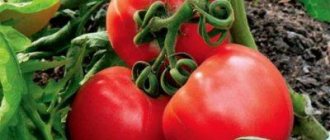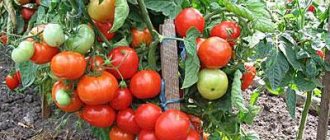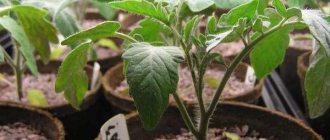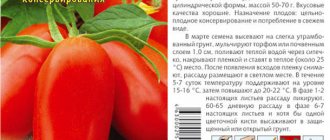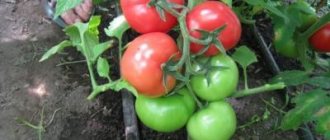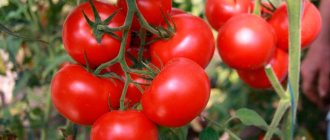The result of many years of successful activity of Russian breeders is the Nastenka f1 tomato. Bred in 2008. The variety is the embodiment of productivity, endurance to any stress, and excellent resistance to pathogens.
| Height | Landing location | Ripening time | Fruit color | Fruit size | Origin | Fruit shape |
| Medium height | Greenhouse, Open ground | Early ripening | Pink | Average | Variety | Flat-round |
Tomato Nastenka: variety description
| Variety name | Nastenka |
| general description | Early maturing hybrid of determinant type |
| Originator | Russia |
| Ripening period | 80-95 days |
| Form | Fruits are round |
| Color | The color of ripe fruits is red |
| Average weight of tomatoes | 150-200 grams |
| Application | Versatile, suitable for both salads and canning |
| Productivity of the variety | 10-12 kg per square meter |
| Features of cultivation | To increase productivity, watering and fertilizers are necessary |
| Disease resistance | Resistant to most diseases |
Tomato Nastenka is a very popular early ripening variety.
According to the type of bush, it belongs to standard determinate plants, that is, it continues to grow throughout the entire season, producing more and more new fruits. This quality is liked by many gardeners, both experienced and beginners. The bush is low, only 50-70 centimeters . Read about indeterminate varieties here.
The Nastenka tomato variety is equally well suited for growing both in open ground and under film, in greenhouses, in glass and polycarbonate greenhouses. Of the diseases, it is especially resistant to late blight.
At the ripe stage, the fruits are red in color and medium-sized, round in shape. Ripe tomatoes can reach 150-200 grams, that is, medium size . The fruits have an average of 4-6 chambers and contain 4-6% dry matter. The taste of the fruit is pleasant, delicate, with sufficient sugar content.
The information in the table below will help you compare the weight of the fruits of this variety with others:
| Variety name | Fruit weight |
| Nastenka | 150-200 grams |
| Snowfall | 60-75 grams |
| Altaic | 50-300 grams |
| Yusupovsky | 500-600 grams |
| Premier | 120-180 grams |
| Andromeda | 70-300 grams |
| Stolypin | 90-120 grams |
| Red bunch | 30 grams |
| Lazy | 300-400 grams |
| Honey Heart | 120-140 grams |
| Mazarin | 300-600 grams |
Variety care
Nastenka tomatoes are cared for according to a certain scheme, which includes watering, fertilizing and tying up. The variety responds well to the application of phosphorus and potassium fertilizers.
Watering tomatoes
The Nastenka variety needs moderate watering. With a lack of moisture, tomato leaves curl and inflorescences fall off. Excess moisture also negatively affects plants: fungal diseases are activated and the root system rots.
Tomatoes are watered with warm water that has settled in barrels. Moisture should not get on the roots and leaves of plants. The procedure is carried out in the morning or evening so that the water does not evaporate, but goes into the ground.
Regular watering is carried out a week after planting tomatoes. Until the inflorescences appear, the tomatoes are watered every 3 days, using 2 liters of water. When inflorescences form, the tomatoes are watered every week and the volume of water is increased to 5 liters.
During the fruiting period, tomatoes need to be watered every 4 days, the water consumption should be 3 liters. When the fruits begin to turn red, reduce watering and add moisture once a week. According to reviews of the Nastenka tomato, excess moisture during this period causes cracking of the fruit.
After watering, the soil under the bushes is loosened and the trunks are hilled. This procedure ensures air exchange in the soil and improves moisture absorption.
Fertilizer application
Tomato feeding is carried out using mineral fertilizers and folk remedies. Treatment begins a week after transferring the plants to their permanent location.
First, tomatoes are fed with phosphorus, which promotes the growth of the root system. To do this, a 5-liter bucket of water requires 15 g of superphosphate. The resulting planting solution is watered at the root.
After 10 days, potassium fertilizer is prepared, which has the property of improving the taste of fruits and increasing the immunity of tomatoes. Measure 15 g of potassium sulfate per 5 liters of water. The solution is used when watering tomatoes.
Wood ash will help replace mineral fertilizers. It is embedded in the soil under tomato bushes or an infusion is prepared for watering. For the infusion you will need 3 liters of ash, which is poured with 5 liters of water. A day later, the resulting product is diluted with the same amount of water and used for irrigation.
Read also: Prominent pear: description and characteristics of the variety
Pinching and tying
According to the photo and description, the Nastenka tomato variety is low-growing, so it does not require pinching. The plant develops 3-4 stems.
It is recommended to tie the plant stem to a wooden or metal support, especially when grown in areas exposed to wind and precipitation. Tying does not allow the tomatoes to fall to the ground and makes them easier to care for.
Characteristics
The Nastenka hybrid was bred by Russian breeders in 2008, and received registration in 2012. Despite the fact that he is quite young, he has already gained popularity among gardeners.
Nastenka is a tomato that tolerates temperature changes well, which is why it is ideal for all Russian regions . In the regions of Siberia and the Far East it is better to grow in greenhouses, while in the southern and central regions it can be grown in open ground.
Nastenka has excellent taste, making it well suited for fresh consumption.
It is often used for home canning as the size of the fruit is ideal for this and its moisture content makes it a good source of fresh tomato juice.
In addition to resistance to diseases and pests, this type of tomato has earned popularity among gardeners for its high yield. To increase productivity, the plant requires regular watering and mineral fertilizers.
With proper care and favorable conditions, this variety can be high-yielding and produce up to 10-12 kilograms per sq.m.
You can compare the yield of this variety with others in the table below:
| Variety name | Productivity |
| Nastenka | 10-12 kg per square meter |
| Gulliver | 7 kg per bush |
| Honey Heart | 8.5 kg per square meter |
| Broody | 10-1 kg per square meter |
| Lazy | 15 kg per square meter |
| Brawler | 9 kg per bush |
| Black bunch | 6 kg per bush |
| King of the market | 10-12 kg per square meter |
| De Barao the giant | 20-22 kg per bush |
| Rocket | 6.5 kg per square meter |
Pros and cons of tomato
The variety attracted the attention of vegetable growers due to its ability to grow in a temperate climate, ease of care, and early harvest. The Nastenka tomato takes root in Siberia and bears fruit in the Far East, where it is planted in a greenhouse. If agricultural practices are followed, the Nastenka variety gives a good harvest.
The advantages of tomato include:
- long fruiting;
- disease resistance;
- versatility of use.
Vegetable growers value tomatoes for their pleasant sweet taste. During transportation, tomatoes do not lose their presentation, but if there is excess moisture, the skin cracks.
Advantages and disadvantages
Among the main advantages are:
- early ripening variety;
- high productivity;
- unpretentiousness to soil and watering;
- optimal fruit size;
- resistance to major diseases.
Despite a number of advantages, it also has its disadvantages. Plants require certain skills when growing seedlings; beginners may have difficulties. The Nastena tomato variety requires a lot of mineral fertilizers for feeding .
The following are also often used as fertilizers:
- Organic.
- Hydrogen peroxide.
- Ammonia.
- Boric acid.
- Yeast.
- Iodine.
- Ash.
Productivity
From 1 sq. m of planting, 16 - 18 kg of fruits are harvested. The yield from one bush of the Nastena F1 variety is 5 - 8 kg. When grown on an industrial scale, you can harvest from 176 - 507 c/ha. These are high indicators compared to standard varieties. For example, the famous tomatoes Nepravda and Dar Zavolzhye under similar conditions bring a yield of about 159 - 495 c/ha.
Nasten tomatoes are picked ripe or at the stage of technical maturity. The crop ripens without problems at room temperature. The yield of marketable products ranges from 69 to 90%. Due to the compacted skin, Nastena F1 tomatoes are well transported. The shelf life of the crop at home is up to 45 days.
Features of cultivation
Among the features of Nastenka, one can note its productivity and resistance to major tomato diseases. Growing requires light, highly fertile soils, so some effort must be made to obtain the promised harvest. This variety tolerates storage and transportation well.
Read on our website: How to prepare soil in a greenhouse in spring? What soil is suitable for growing seedlings and adult tomatoes in greenhouses? What types of soil for tomatoes are there? And also, the use of growth stimulants, fungicides and insecticides when growing nightshades.
In general, agricultural technology includes standard procedures: planting, tying, watering, mulching, pinching.
Diseases and pests
This type of tomato is resistant to most types of diseases and pests, but is still susceptible to some of them.
The main problems are caused by pests - spider mites and whitefly aphids. To combat mites, a soap solution is most often used, cleaning the affected areas of the plant with it until the pest is completely destroyed.
Confidor is used against whiteflies, making a solution in the proportion of 1 milliliter per 10 liters of water. The plant can also be attacked by slugs, it is easy to fight against them, just sprinkle the soil around the bushes with ash and ground hot pepper, after which the slugs will go away.
Of the diseases, tomato is most often susceptible to fruit cracking. If this problem occurs to you, then you should adjust the watering regime and temperature and the cracking will decrease.
Planting time for seedlings
Seedlings that are planted in a timely manner and in compliance with technology are the key to the quality and yield and quantity of harvested fruits. It is worth planting seeds in grooves 1-1.5 centimeters deep, and for better growth and as a preventive measure against certain diseases, the seeds can be soaked in a solution of potassium permanganate. It is better to bake the soil in the oven before planting seeds - this will help in the fight against pests. The air temperature in the room where week-old seedlings grow should not be lower than 20℃. Nastenka seeds are planted in mid-March and covered with peat or fertile soil. Water the seedlings using a spray bottle, and to speed up growth, the container is covered with polyethylene until the first shoots appear. After waiting for the first two leaves, you should think about picking and transplanting the sprouts into separate containers. Planting in a permanent place takes place 60 days after sowing the seeds, but the sprouts must first be hardened in air.

